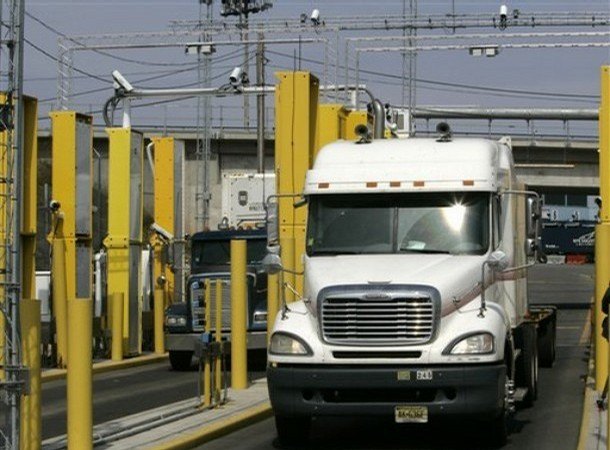Feds to Switch From Polyvinyl Toluene Detectors to Advanced Spectroscopic Portals?
Welcome the wacky world of nuclear bomb detection, as practiced by U.S. border guards protecting The Land of the Free from terrorist infiltration via our neighbors to the north. The Vancouver Sun reports the reassuring news that “every car, truck and passenger entering the United States by land from Canada is now searched for nuclear weapons.”
And how do they do that? Not so well, it seems. The feds have installed polyvinyl toluene or PVT monitors alongside the car lane approaches to customs’ booth inspections, with larger monitors for transport trucks in cargo inspection areas. “Each detects certain types of energy within a limited area but not the exact radioactive source. For that a suspect vehicle is sent for a secondary inspection that includes a scan with a hand-held detection device to identify the source and whether it constitutes a threat. Benign emissions from lingering medical isotopes in people’s bodies, scrap metal, natural sources of radiation and even Kitty Litter trigger frequent false alarms . . .
What’s more, PVT monitors can only detect unshielded or lightly shielded sources, which seems unrealistic, considering the sophisticated smuggling tactics determined nuclear terrorists would likely employ.” The solution? More technology of course.
The U.S. is instead debating the cost-effectiveness of replacing PVT technology with “advanced spectroscopic portals” or ASP, a new type of portal monitor designed to both detect radiation and identify the source.
The U.S. Government Accounting Office reports that ASP monitors use more sophisticated software, and have a more extensive library of radiation signatures that may provide more consistent and rapid screening and may increase the likelihood of correct identification. But they’re also almost three times more expensive than PVT monitors.
Still, one nuclear bomb can ruin your whole day.
More by Robert Farago
Latest Car Reviews
Read moreLatest Product Reviews
Read moreRecent Comments
- Tassos Jong-iL Not all martyrs see divinity, but at least you tried.
- ChristianWimmer My girlfriend has a BMW i3S. She has no garage. Her car parks on the street in front of her apartment throughout the year. The closest charging station in her neighborhood is about 1 kilometer away. She has no EV-charging at work.When her charge is low and she’s on the way home, she will visit that closest 1 km away charger (which can charge two cars) , park her car there (if it’s not occupied) and then she has two hours time to charge her car before she is by law required to move. After hooking up her car to the charger, she has to walk that 1 km home and go back in 2 hours. It’s not practical for sure and she does find it annoying.Her daily trip to work is about 8 km. The 225 km range of her BMW i3S will last her for a week or two and that’s fine for her. I would never be able to handle this “stress”. I prefer pulling up to a gas station, spend barely 2 minutes filling up my small 53 liter fuel tank, pay for the gas and then manage almost 720 km range in my 25-35% thermal efficient internal combustion engine vehicle.
- Tassos Jong-iL Here in North Korea we are lucky to have any tires.
- Drnoose Tim, perhaps you should prepare for a conversation like that BEFORE you go on. The reality is, range and charging is everything, and you know that. Better luck next time!
- Buickman burn that oil!

































Comments
Join the conversation
Well, of course everyone knows that the 9/11 hijackers entered the US from Canada. Oh, wait a minute. They didn't. Jeff's point about the "millenium bomber" is correct. Funnily enough, I went on a week long motorcycle trip in WA, OR and CA this past summer and I entered the US in Port Angeles, the very entry point where Ressan was caught. The three bikers ahead of me and I were all pulled aside after going through the detectors. All of us (none of whom were traveling together) had apparently caused the detectors to go off. They came to each of us with handheld geiger counters (or so it appeared) and ran it over the bike, luggage and our bodies. They seemed visibly flustered to have so many apparent alarms in a row. It took about 15 minutes to finally get cleared (to the chagrin of my gf who did not get stopped and was stuck waiting). The irony is that they were so worked up about the false alarm they didn't ask me any questions! I could have been smuggling all kinds of stuff and they wouldn't have noticed, as long as it didn't set off their handheld sniffers.
My aunt and a carload of friends were delayed at the border and sat in a room for about an hour before one of the interrogators finally asked "which one of you had chemotherapy not too long ago. " My aunt had undergone chemotherapy about 2 months before. So those detectors are really sensitive.